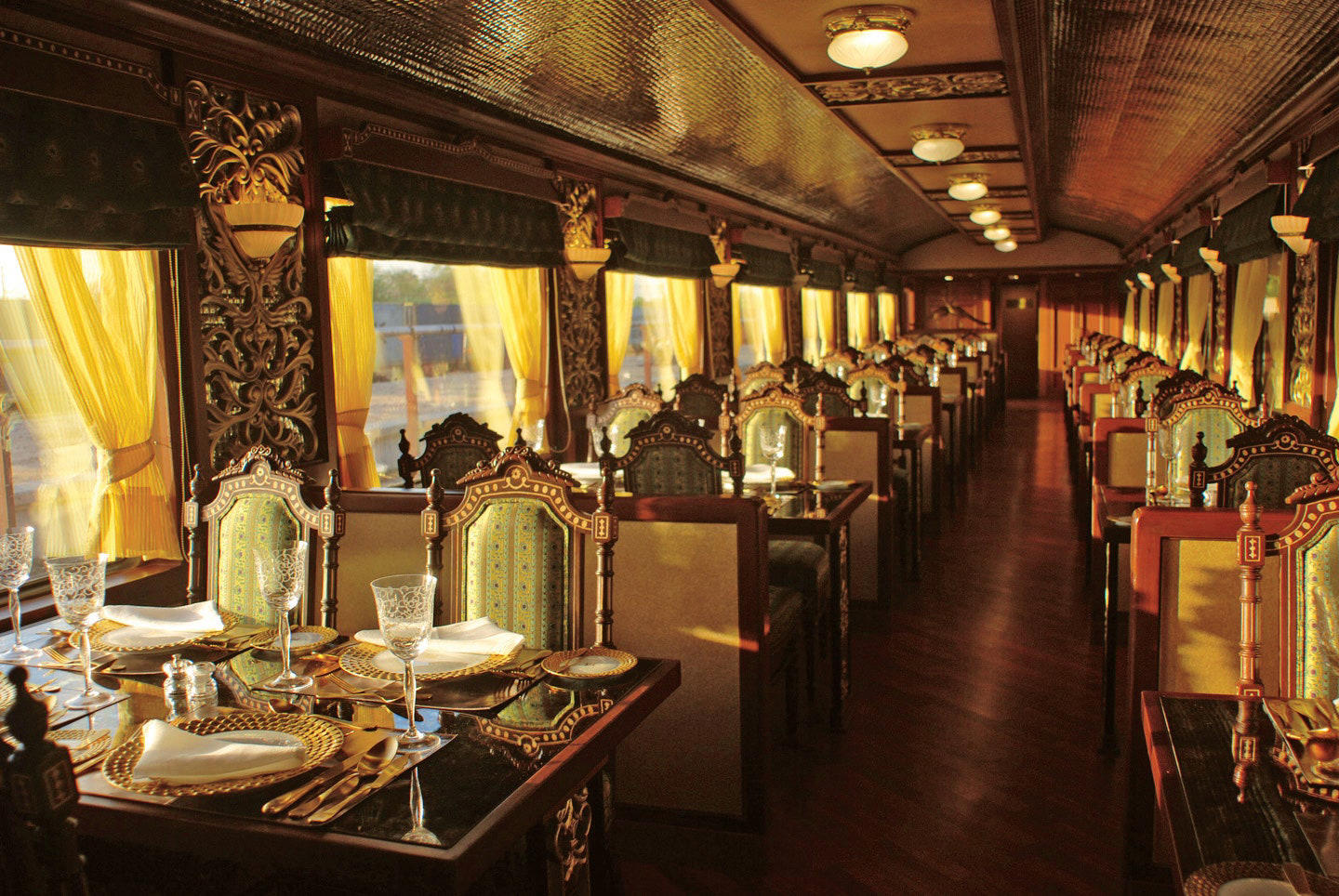Luxury Train Travel Is Entering Another Golden Age
7 min read
On August 26, an unusual rail journey set out from Vancouver, British Columbia, with an itinerary stringing together seven pre-existing luxury train lines across four continents, starting in North America, zigzagging through Europe and Africa, before concluding in Asia (with a few international flights in between). The trip, packaged by specialist travel agency Railbookers, started from $113,599 per person. And its popularity resulted in a waitlist of more than 500 people before the expanded 2025 offerings went on sale this month.
The “Around the World By Luxury Train” travel packages are, even by price-point alone, niche. The average traveler merely needs to get from point A to B efficiently and affordably, and most of the tourism industry still caters to those needs. But the growing demand for luxury rail speaks to a larger shift happening in the upper reaches of the travel market.
On one hand, this mode of travel seems to be meeting the moment, as preferences for “slow travel” persist. “Ever since Covid, there has been a boom in this desire to slow down and do something a bit different and in a different way,” says Samy Ghachem, general manager of the forthcoming La Dolce Vita Orient Express, promoted as Italy’s first luxury train. It’s one of several developments under the expanding Orient Express brand from Accor Group, and it offers eight distinct roundtrip itineraries setting out from Rome in 2025.
Nostalgia is certainly a factor in the appeal. It might be tempting to view these plush train carriages as a kind of Gilded Age cosplay—as if meticulously designed Wes Anderson sets have come to life (the director actually did design a car on the British Pullman, a luxury train under the Belmond portfolio). In an era of booming luxury travel, where major openings routinely promote “immersive experiences” and “narrative” concepts, it’s not surprising to see Accor’s Orient Express trading in the legendary status of its name. In fact, another beloved train also, confusingly, operates under the iconic moniker: the Venice Simplon-Orient-Express belongs to Belmond and travels occasionally through Italy. (When Accor’s trains hit the tracks, be ready for train travel pedants to remind you of the differences.)
But rail travel’s glamorous moment in the sun, one might argue, isn’t wholly about reliving the past so much as finding novel ways to be present. And it’s pushing the market far beyond the most storied routes, with soon-to-launch lines veering off to lesser-visited destinations and stopping frequently for tailored off-train excursions.
This has been a “record-breaking” year for rail bookings
One day in early September, Andrew Channell had his coffee watching the sunrise as he cruised through the Peruvian Andes at about 14,000 feet above sea level. He was aboard the exclusive Andean Explorer, which carries a maximum of 70 guests in 32 cabins. It was a trip that confirmed many of the reasons he believes travel by train is having a moment: “With rail, the journey is the journey,” Channell tells me. “It’s not just about recreating some historic epic. It’s about slowing down and enjoying every moment.”
A lot of people seem to be getting on board, too. Railbookers, where Channell is senior vice president of product, describes 2024 as “record-breaking” for sales, which are up 30% year over year. Luxury journeys, in particular, have seen a 43% increase compared to 2023. “That massive increase isn’t just in one place, either. It’s not driven by any one destination or any one campaign,” he observes. “It’s driven by demand for these types of experiences all over the place.”
In the post-pandemic era, Railbookers attribute the uptick to a desire for connecting with destinations in ways only trains can do. “That sense of specialness, exclusivity, rarity, and [of something] once-in-a-lifetime—that’s what’s driving it,” Channell says. This generation of sleeper trains take the typical displeasure of getting from one place to another—and, clearly, flying is often the more stressful part of any trip—and makes it pleasurable. “It comes down to enjoying the entirety of your journey from end to end.”
That growth extends beyond the typically affluent demographics to a group dubbed by Matt Foy, Railbookers’ senior director of rail and transportation, as “the little-bit-of-luxury traveler.” These travelers are tacking luxury rail segments onto an otherwise moderately priced vacation, he explains: “Post-pandemic, the demand for ‘the little bit of luxury’ has increased and is on an ever-upward curve.”
The demand isn’t new, but these kinds of journeys are on more and more people’s bucket lists. This certainly includes iconic journeys such as South Africa’s Rovos Rail, Canada’s Rocky Mountaineer, and India’s Maharajas’ Express. Increasingly, the focus is also on newer lines that take travelers to destinations previously unvisited by luxury trains, from South America and rural Japan to new roundtrip itineraries slowly weaving around Italy.
The future of luxury rail is, well, off the beaten track
The much delayed La Dolce Vita train exemplifies several overlapping trends. One is slow: rather than high-speed rail, which prioritizes efficiently connecting destinations, this new wave of excursion trains travel at around 80 kilometers an hour—or roughly 50 miles per hour. Another is the focus on localization. “It’s the first luxury train slow cruise concept of its kind in Italy,” asserts Ghachem, underscoring that all of La Dolce Vita’s journeys begin and end in Rome. This is one point of differentiation with the continent’s existing Venice Simplon-Orient-Express from Belmond, which connects many different points throughout Europe.
For more on train journeys that you can experience (at various price points), head over to The World’s Most Iconic Train Journeys, a spotlight on the world’s most legendary railway adventures, from luxury trains that evoke old-world glamour to historic routes that have rebuilt nations.
The excursion concept reflects the popularity of several luxury trains that launched throughout the 2010s in Japan. Though the country is famous among train buffs for its speedy bullet trains, it’s also got the luxuriously slow Seven Stars by JR Kyushu, which gained a global fanbase after its launch in 2013. It’s known for spacious carriages, filled with handcrafted Japanese furnishings, and its circular itinerary. Seven Stars circuits the island of Kyushu over four days and three nights, with stops at onsens, shrines, and more cultural sites.
La Dolce Vita echoes many of the same ideas that made Seven Stars famous. An all-things-Italian angle comes through in the design heritage that Milan’s interior architecture firm Dimorestudio embedded in each carriage, upcycled from vintage 1970s trains. The attention to elevated design and more spacious quarters are key to the experience, too—yes, that means en suite bathrooms and showers for every cabin. It also means from grand architectural gestures down to even cutlery selections that every detail pays homage to Italy’s 20th-century “La Dolce Vita” era, with interiors evoking the works of design icons of the period.
Another similar key element to La Dolce Vita is its focus on going to regions in Italy where high-end train services haven’t really gone before. The itineraries total more than 9,941 miles of track, touching more remote destinations such as the ancient stone-carved architecture in the cliffy city of Matera in Basilicata as well as Palena, a village in Abruzzo. And for a truly unprecedented journey to the island of Sicily, passengers watch as the train is decoupled and loaded on a ferry to cross the Strait of Messina before being reassembled to continue the journey on the other side. There’s even an itinerary dedicated to truffles.
The slow travel trend keeps picking up speed
In a country overwhelmed with overtourism, the exclusive nature of La Dolce Vita means another draw for passengers is that it’s an escape from crowds, “a chance to double down on the Italian experience and access parts of Italy that they might not normally consider,” Ghachem says. Accor’s expanding Orient Express will bet on demand for that experience far beyond Italy in 2025, with perhaps the most anticipated of all upcoming launches: Accor’s “the Orient Express” line. Architect Maxime d’Angeac resurrects a few old-school Nostalgie Istanbul Orient Express carriages from the 1920s and ’30s, which will soon trace a similar route to the historic original from Paris to Istanbul.
In other words, the major players in the sector are betting that this particular breed of slow travel is doing anything but slowing down. Accor’s new Orient Express lines will compete with Belmond’s Venice Simplon-Orient-Express, which continues to diversify its European itineraries. Meanwhile, other regional players such as East Japan Railway Company have helped propel the slow-cruising rail experience to new heights with the Train Suite Shiki-Shima, launched in 2017, which guests can apply to book and may get a ticket to ride via a lottery for one of its 34 spots.
In a world where even luxury travel can feel homogenized, there’s a certain poetry to the growth in high-end rail journeys that are idiosyncratic—and intentionally not high-speed. “The growing trend for luxury is slowing down, is taking a deeper breath, is seeing more and enjoying the journey,” concludes La Dolce Vita’s Ghachem. And while the so-called “golden age” of train travel may be overly romanticized in the marketing, the rail revival seems like it might, in fact, rival the myth.
- Want to be the first to know? Sign up to our newsletters for travel inspiration and tips
- The Golden Rules of Road Tripping
- The Best Time to Visit Japan—and How Many Days to Stay
- These 7 Charming European Towns Are Frozen in Time
- The EU’s New Carry-On Luggage Rules Explained



